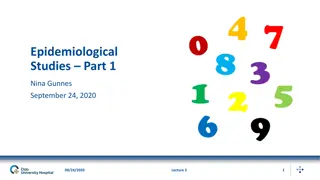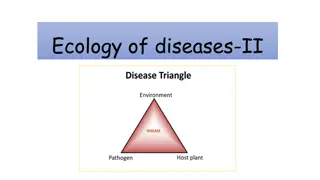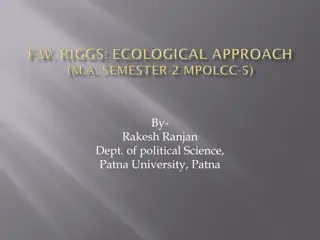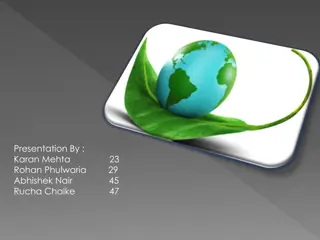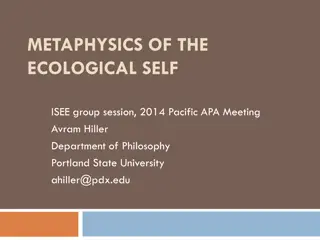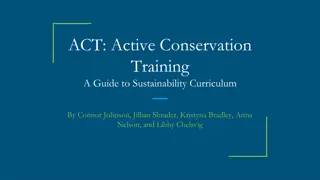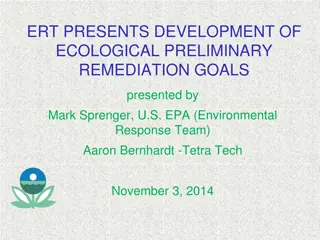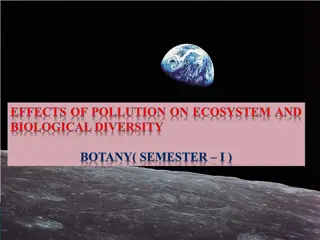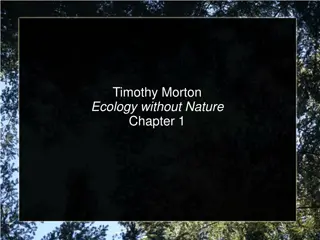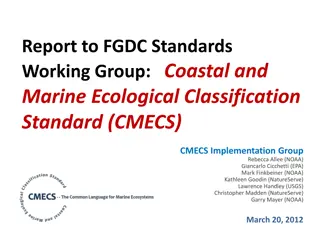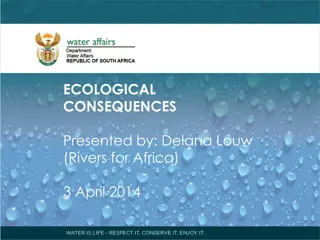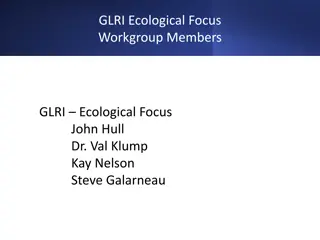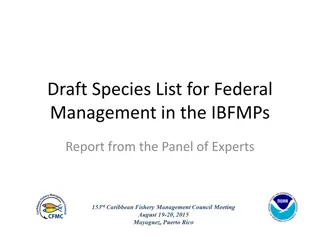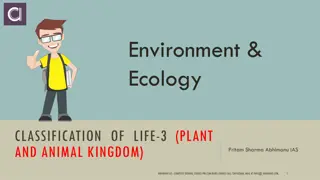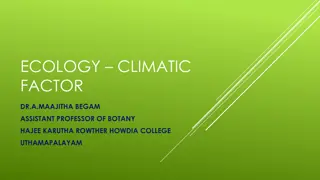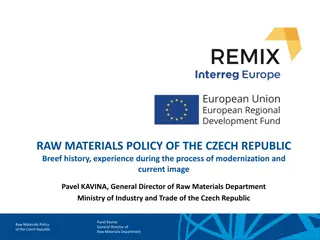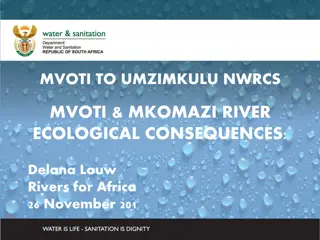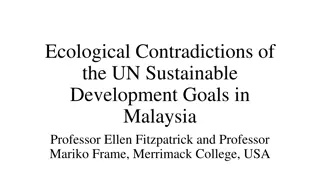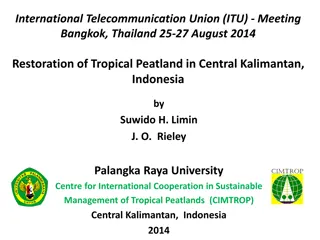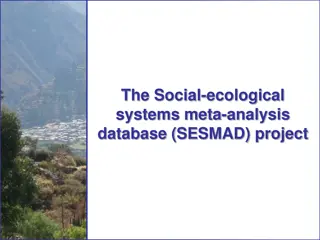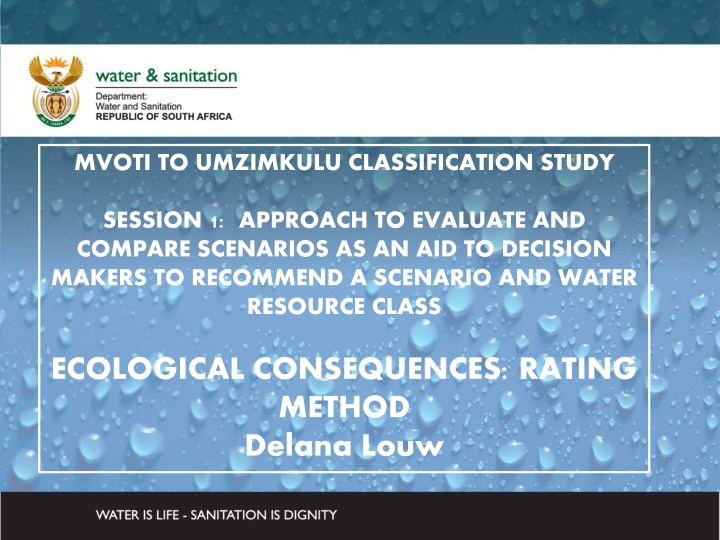
Ecological Consequences and Scenarios Study for Water Resources Management
Explore the ecological consequences of scenarios in water resource management to aid decision-making processes. Assess changes in biophysical components and ecosystem health to determine the best course of action for conservation. Delve into the impacts of proposed interventions on habitats and biodiversity, focusing on the potential repercussions of various scenarios.
Download Presentation

Please find below an Image/Link to download the presentation.
The content on the website is provided AS IS for your information and personal use only. It may not be sold, licensed, or shared on other websites without obtaining consent from the author. If you encounter any issues during the download, it is possible that the publisher has removed the file from their server.
You are allowed to download the files provided on this website for personal or commercial use, subject to the condition that they are used lawfully. All files are the property of their respective owners.
The content on the website is provided AS IS for your information and personal use only. It may not be sold, licensed, or shared on other websites without obtaining consent from the author.
E N D
Presentation Transcript
MVOTI TO UMZIMKULU CLASSIFICATION STUDY DWA CORPORATE IDENTITY Presented by: Johan Maree Deputy Director: Media Production COMPARE SCENARIOS AS AN AID TO DECISION MAKERS TO RECOMMEND A SCENARIO AND WATER RESOURCE CLASS SESSION 1: APPROACH TO EVALUATE AND 12 December 2012 ECOLOGICAL CONSEQUENCES: RATING METHOD Delana Louw
Determining ecological consequences of scenarios Need to answer the what if questions Express in terms of change in Ecological Category AND degree in which the REC is met Detailed process to predict changes in all the biophysical components per site and per scenario. Then to integrate and demonstrate in systems context Include in MC DSS process 2
Determining ecological consequences of scenarios Geomorphology Geomorphology Geomorphology AVERAGE SCORE FOR EACH SCENARIO & STANDARDISE TO 1 Physico-chemical Physico-chemical Physico-chemical Fish Fish Fish Macroinvertebrates Macroinvertebrates Macroinvertebrates Riparian vegetation Riparian vegetation Riparian vegetation Consequences EC FOR PES & REC Consequences EC FOR SC Consequences COMPARE EC TO REC Evaluate scenarios Determine PES, REC and % Predict EC and % Determine degree to which REC is met Rank Scenarios at each EWR site
Determining ecological consequences of scenarios Ecological ranking of scenarios per EWR site RELATIVE ECOLOGICAL IMPORTANCE OF SITES PES EIS Locality in conservation areas Confidence Length of river APPLY WEIGHT TO OUTPUT Ecological ranking of scenarios for the system WEIGHT
MKOMAZI RESULTS Proposed Smithfield Dam MK_I_EWR 1 MK_I_EWR 2 MK_I_EWR 3 Sappi Estuary
MK_I_EWR1: Component ecological consequences PES & REC A/B A/B B B/C Sc Sc Sc MK2 Sc MK21 Sc MK31 Sc MK4 Sc MK41 Sc MK42 MK22, 23 MK32, 33 Component C A/B B/C B/C B/C A/B C C C B B C C C B C D A/B B/C C C A/B C C C Phys chem Geom Fish Inverteb C/D D D B/C C C C/D C D C C C C C/D C/D C/D Rip veg C D C C C C C/D C C EcoStatus Geomorphology - reduced to different degrees - impact of the dam on sedimentation and possible erosion and accumulation of fines. These habitat changes impact on the instream biota (worst scenarios are Sc MK2 and 4 as they do not include EWR). This results in a lack of fast flowing habitats and possible reduction and/or eradication of ANAT and BNAT Scenarios that include EWR releases are an improvement, but the unseasonal releases and at times higher flows than natural are problematic.
MK_I_EWR1: Scenario ranking Most of the scenarios meet the ecological objectives in terms of EcoStatus except for Sc MK4 and MK2. These two scenarios do not cater for EWR requirements and are similar, however under Sc MK2 lower flows occur in all months and zero flows occur during drought periods in Oct Dec and therefore Sc MK2 has the greatest impact. None of the scenarios meet the ecological objectives for all the components. Sc Mk 21 are the best of the options overall and is therefore ranked the highest
MK_I_EWR2: Component ecological consequences Sc PES & REC Sc MK21 MK22, 23, 32, 33 A/B C C B/C B/C B/C Sc MK31 Sc MK41 Sc MK42 Sc MK2 Sc MK4 Component Phys chem Geom Fish Inverteb Rip veg EcoStatus A/B B B B B B C C D D C C A/B C C B/C B B A/B C C B/C B B/C B C A C A C C/D C C C B/C B B B B/C B/C B B Geomorph reduced to a C due to the impact of the dam on sedimentation, channel narrowing and an increase in embeddedness.. These habitat changes impact on the instream biota. The worst scenarios are Sc MK2 & 4 (no EWR releases). The other scenarios include increased high flows in the dry season with a loss of slow habitats which impact on Barbus anoplus and Barbus viviparus.
MK_I_EWR2: Scenario ranking None of the scenarios meet the ecological objectives. Although Sc MK21, 41 and 42 results in the same EcoStatus, the instream biota are impacted by the reduced wet season base flows and reduced floods. Sc MK41 is the best scenario of these three scenarios because it provides more flows during wet season. Scenario MK2 and MK4 has the worst impact due to reductions in baseflows during dry and wet seasons.
MK_I_EWR3: Scenario ranking PES & REC Sc MK21, 31, 41 Sc MK22, 23, 32, 33 Sc MK42 Sc MK2 Sc MK4 Component Phys chem A/B B/C A/B B B/C B Geom Fish B B C C B/C B/C C C C C C C Inverteb B C/D B/C C C/D C Rip veg D D D D D D EcoStatus C D C C D C/D Geomorphology impacts are not as severe as US - distance of the dam. Reduction of large flood & delayed early wet season floods still cause impacts. The worst scenarios are Sc MK2 & 4 (no EWR releases). The deterioration in instream biota (small), is related to the low flows for drought in wet months and impact on spawning
MK_I_EWR3: Component ecological consequences Geomorph: The results illustrate that none of the scenarios meet the ecological objectives. Sc MK 21, 31 and 41 results in the same EcoStatus and has the least impact with a slight deterioration in geomorphology and instream biota. Sc MK22, 23, 32 and 33 also has the same EcoStatus as the PES/REC but there is further deterioration in the instream biota as well as geomorphology and water quality. Scenario MK2 and 4 have the biggest impact as overall they drop a category for while Sc MK42 only caters for the low flow EWR and the impact is therefore slightly less, i.e. it drops half a category 1.00 PES REC 0.96 Sc MK21, 31 & 41 0.92 Sc MK22, 23, 32 & 33 Sc MK42 0.88 0.84 Sc MK2 & 4 0.80
MKOMAZI RIVER: INTEGRATED CONSEQUENCES PES REC Sc MK2 Sc MK21 Sc MK22 & 23 Sc MK31 Sc MK32 & 33 Sc MK4 Sc MK41 Sc MK42 PES REC 0.98 Sc MK21 Sc MK41 0.93 Sc MK31 Sc MK22 & 23 Sc MK42 0.88 Sc MK32 & 33 0.83 Sc MK4 0.78 0.73 Sc MK2 0.68 Mk_I_EWR1 Mk_I_EWR2 Mk_I_EWR3
MKOMAZI RIVER: SITE WEIGHTING Locality in protected areas 1 3 1 EWR site DistNormalised Weight PES EIS Conf EWR 1 EWR 2 EWR 3 Moderate High Moderate 3.4 3.5 3.4 0.08 0.32 0.6 C B C 0.22 0.37 0.41
MKOMAZI RIVER: INTEGRATED RANKING Sc MK 21 and 41 are the best options as they are the closest to meeting the ecological objectives. Both these scenarios include the total EWR flows and the impacts are mostly due to the impacts on the dam itself, such as the barrier effect, impact on larger frequency of floods and largely due to the increased (above natural) base flows.
MKOMAZI ESTUARY: SENSITIVITIES Decreased base flows especially important for mouth closure. Salt penetration Decreased flooding (large estuary flooding bigger impact than eg on the Mvoti NB: Much improvement can be achieved by removing weir (illegal)
MKOMAZI RIVER & ESTUARY: SITE WEIGTING River Weight 0.22 0.37 0.41 EWR site PES EIS System Weight EWR 1 EWR 2 EWR 3 Estuary Moderate High Moderate High C B C C 0.17 0.28 0.31 0.25
MKOMAZI RIVER & ESTUARY: INTEGRATED RANKING RIVERS ONLY RIVERS & ESTUARY
MV_I_EWR2: COMPONENT ECOLOGICAL RIVER CONSEQUENCES PES & REC C C B/C B/C C/D C Sc MV3 Sc MV41 Sc MV42, 43 Component Phys chem Geom Fish Inverteb Rip veg EcoStatus C/D C/D C/D C/D D D C C B/C C/D C B/C C/D C B/C B/C C/D C Sc MV3 is the worst case as it does not include EWR releases. The channel will narrow with vegetation encroachment. An overall loss of fast habitats will impact on the instream biota. Impacts associated with Sc MV42 and 43 are less pronounced as it includes EWR releases to some degree. Sc MV 41 supplied the total EWR and therefore meets the ecological objectives.
MVOTI ESTUARY: SENSITIVITIES Decreased base flows especially important for mouth closure. Salt penetration Decreased flooding (small estuary flooding smaller impact than eg on the Mvoti Major impact associated with sand mining
MVOTI ESTUARY & RIVER: RANKING The ranking is the same for the rivers and estuary. Weights need to be selected to provide ecological system rating. Estuary probably much less important than Mkomazi and rivers more important - used 15%. Irrespective of the weights, the ranking order will not change as can be seen.
MVOTI RIVER & ESTUARY: INTEGRATED RANKING RIVERS ONLY RIVERS & ESTUARY

